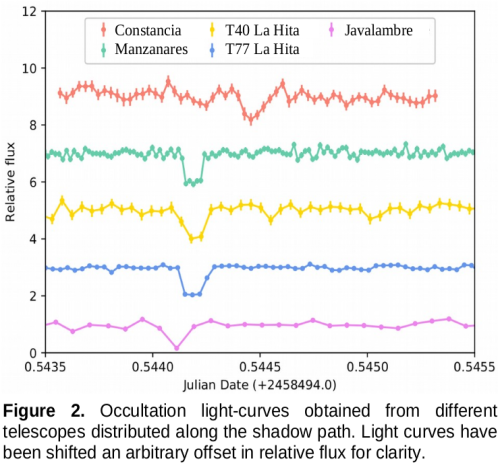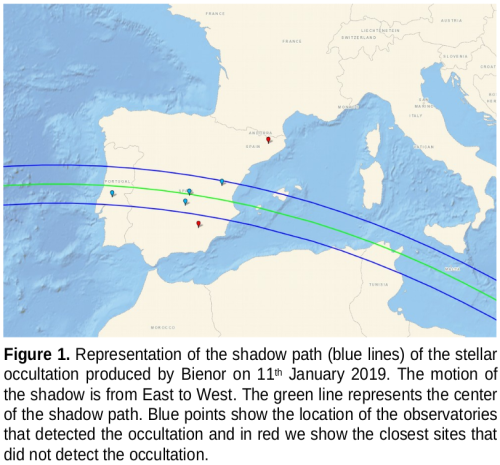- 1Instituto de Astrofísica de Andalucía (CSIC), Solar System, Granada, Spain (psantos@iaa.es)
- 2Florida Space Institute (UCF), Orlando, USA
- 3LESIA, Observatoire de Paris, Université PSL, CNRS, Sorbonne Université, Univ. Paris Diderot, Sorbonne Paris Cité,Meudon, France
- 4Laboratório Interinstitucional de e-Astronomia-LineA, Rio de Janeiro, Brazil
- 5Observatório do Valongo/UFRJ, Rio de Janeiro, Brazil
- 6Observatório Nacional (ON/MCTIC), Rio de Janeiro, Brazil
- 7Federal University of Technology - Paraná (UTFPR / DAFIS), Curitiba, Brazil
- 8naXys, University of Namur, Rempart de la Vierge, Namur, Belgium
- 9IMCCE-CNRS, Observatoire de Paris, PSL Université, Sorbonne Université, Paris, France
- 10Observatorio Astronómico La Hita, Toledo, Spain
- 11Centro de Estudios de Física del Cosmos de Aragón, Teruel, Spain
- 12Departamento de Astrofísica, Universidad de La Laguna, La Laguna, Spain
- 13Software Engineering Department, University of Granada, Granada, Spain
- *A full list of authors appears at the end of the abstract
1 Introduction
Centaurs are objects that orbit the Sun with semi-major axis between those of Jupiter and Neptune, according to the JPL Horizons definition https://ssd.jpl.nasa.gov/sbdb_help.cgi?class=CEN. These objects are thought to come from the trans-Neptunian region being injected into inner parts of the solar system due to planetary encounters, mostly with Neptune [1]. Therefore, centaurs present an excellent opportunity to study smaller trans-Neptunian objects much closer to the Earth, providing a better characterization of their physical properties. During the last years, there has been a growing momentum in the interest about the centaur population due to the discovery of ring systems around two of them, Chariklo [2] and Chiron [3,4], which has opened a new branch of research in order to understand how such rings are formed and how they can survive around these small bodies.
(54598) Bienor is one of the largest centaurs known to date, with a diameter of ∼ 200 km estimated from Herschel Space Observatory, Spitzer Space Telescope and ALMA thermal measurements [5,6], similar to that of Chiron and Chariklo. Bienor also has ellipsoidal shape and water ice spectral features analogous to Chariklo and Chiron [7,8,9], although its rotation period of ∼ 9.14 h, without being very slow, is slightly over the average of the TNO/centaur population [10]. From the similarities with Chariklo and Chiron and from other reasons it has been proposed that Bienor could possess a ring system, similar to what has been found in the above mentioned centaurs [9].
2 Observations
Within our program of physical characterization of TNOs and centaurs, a stellar occultation by the centaur Bienor was predicted to occur on January 11, 2019, with good observability potential. High accuracy astrometry runs were carried out to refine the prediction, and as a result, a shadow path favorable for the south of Europe was derived. This encouraged us to carry out an occultation observation campaign that resulted in 5 positive detections from 4 observing sites located in Spain and Portugal (see Figure 1 and Figure 2). Apart from occultations by the centaurs Chiron [3,4], Chariklo [2,11,12] and 2002 GZ32 [13], no other multichord occultations by centaurs had ever been obtained.
|
|
 |
3 Results
From the analysis of the occultation chords we obtain the instantaneous limb fit of Bienor at the moment of the occultation and combining this information with rotational light curves obtained shortly after the occultation, we infer the rotational phase at the time of the occultation and the three dimensional shape of this Centaur under the assumption of a triaxial ellipsoidal shape. The area-equivalent diameter and geometric albedo are also derived and its mass density can be constrained under the assumption of hydrostatic equilibrium. Our results are compared with radiometric results obtained using Herschel Space Observatory, Spitzer Space Telescope and ALMA facilities. Besides, we explored the potential presence of a ring system and we found no clear hints for rings, but constraints on debris material orbiting Bienor will be presented.
Acknowlegements: P.S-S. acknowledges financial support by the Spanish grant AYA-RTI2018-098657-J-I00 "LEO-SBNAF" (MCIU/AEI/FEDER, UE). We would like to acknowledge financial support from the State Agency for Research of the Spanish MCIU through the “Center of Excellence Severo Ochoa” award for the Instituto de Astrofísica de Andalucía (SEV-2017-0709) and the financial support by the Spanish grant AYA-2017-84637-R. This campaign was carried out within the “Lucky Star" umbrella that agglomerates the efforts of the Paris, Granada and Rio teams. It is funded by the European Research Council under the European Community’s H2020 (2014-2020/ERC Grant Agreement No. 669416). Part of the research leading to these results has received funding from the European Unions Horizon 2020 Research and Innovation Programme, under Grant Agreement No. 687378 (SBNAF). E.F-V acknowledges UCF 2017 Preeminent Postdoctoral Program (P3). F.L.R is thankful for the support of the CAPES scholarship.
References
[1] Fernandez J. A., 1980, MNRAS, 192, 481
[2] Braga-Ribas F., Sicardy, B., Ortiz, J. L., et al., 2014, Nature, 508, 72
[3] Ortiz J. L., Duffard, R., Pinilla-Alonso, N., et al., 2015, A&A, 576, A18
[4] Ruprecht J. D., Bosh A. S., Person M. J., et al., 2015, Icarus, 252, 271
[5] Duffard R., Pinilla-Alonso N., Santos-Sanz P., et al., 2014, A&A, 564, A92
[6] Lellouch E., Moreno R., Müller T., et al., 2017, A&A, 608, A45
[7] Dotto E., Barucci M. A., Boehnhardt H., et al., 2003, Icarus, 162, 408
[8] Rabinowitz D. L., Schaefer B. E., Tourtellotte S. W., 2007, AJ, 133, 26
[9] Fernández-Valenzuela E., Ortiz J. L., Duffard R. et al., 2017, MNRAS, 466, 4147
[10] Thirouin A., Noll K. S., Ortiz J. L., Morales N., 2014, A&A, 569, A3
[11] Bérard D., Sicardy B., Camargo J.I.B., et al., 2017, AJ, 154, 144
[12] Leiva R., Sicardy B., Camargo J.I.B., et al., 2017, AJ, 154, 159
[13] Santos-Sanz P., Ortiz J. L., Sicardy B., at al., submitted to MNRAS
Antonio Román(14), Rui Gonçalves(15), Maximo Ferreira(15),Wolfgang Beisker(16,17), Víctor Casanova(1), Alberto J. Castro-Tirado(1), Luis Escaned Buera(18), Mario Garcés(18), Stephan Hellmich(19), Csaba Kiss(20,21), Abel Laporta(18), José Luis Maestre(22), José María Madiedo(1), Luigi Mancini(23), Stefano Mottola(19), Andras Pal(20), Carlos Perelló(24,17), Antoni Selva(24,17), Josep M. Trigo-Rodríguez(25,26), Fernando Ballesteros(27), Ignacio de la Cueva(28), Kosmas Gazeas(29), Jose Carlos Guirado(27,30), Sensi Pástor(31), Vicent Peris(27), José Antonio de los Reyes(31) ------- 14 Sociedad Astronómica Granadina (SAG), Granada, Spain / 15 Centro Ciencia Viva de Constancia, Constancia, Portugal / 16 Internationale Amateursternwarte (IAS) e. V., München, Germany / 17 International Occultation Timing Association–European Section (IOTA-ES), Germany / 18 OATA-Agrupación Astronómica de Huesca, Spain / 19 German Aerospace Center (DLR), Institute of Planetary Research, Berlin, Germany / 20 Konkoly Observatory, Research Centre for Astronomy and Earth Sciences, Budapest, Hungary / 21 ELTE Eötvös Loránd University, Institute of Physics, Budapest, Hungary / 22 Observatorio de Albox, Albox, Spain / 23 Department of Physics, University of Rome Tor Vergata, Rome, Italy / 24 Agrupació Astronòmica de Sabadell, Barcelona, Spain / 25 Institute of Space Sciences (CSIC), Barcelona, Spain / 26 Institut d’Estudis Espacials de Catalunya (IEEC), Barcelona, Spain / 27 Observatori Astronòmic de la Universitat de València, Paterna, Spain / 28 Astroimagen, Ibiza, Spain / 29 Section of Astrophysics, Astronomy and Mechanics, Department of Physics, National and Kapodistrian University of Athens, Athens, Greece / 30 Departament d’Astronomia i Astrofísica, Universitat de València, Burjassot, Spain / 31 La Murta Observatory-Astromurcia, Murcia, Spain.
How to cite: Santos-Sanz, P., Morales, N., Fernández-Valenzuela, E., Ortiz, J. L., Sicardy, B., Benedetti-Rossi, G., Vara-Lubiano, M., Assafin, M., Rommel, F. L., Pereira, C. L., Braga-Ribas, F., Souami, D., Duffard, R., Vieira Martins, R., Organero, F., Ana Hernández, L., Fonseca, F., Iglesias Marzoa, R., Lamadrid, J. L., and Alonso, S. and the 'Lucky Star' and Bienor stellar occultation teams: The January 11th, 2019 stellar occultation by the elongated centaur Bienor, Europlanet Science Congress 2020, online, 21 Sep–9 Oct 2020, EPSC2020-784, https://doi.org/10.5194/epsc2020-784, 2020.


